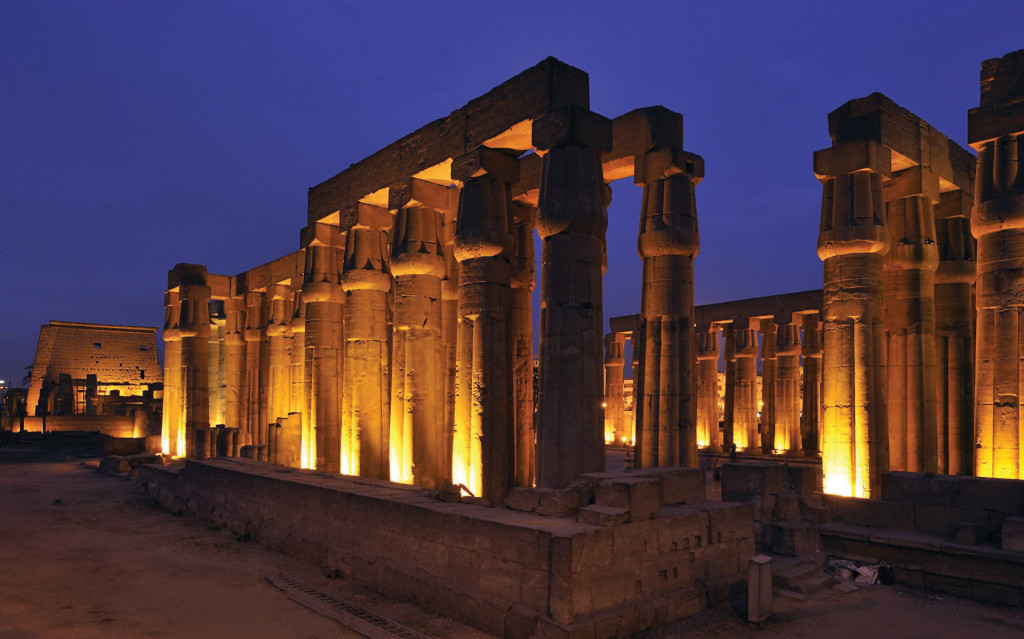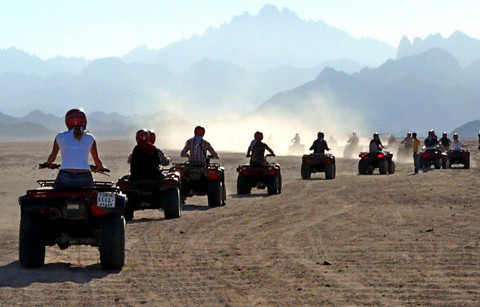| The Eastern Desert, also called the Arabian Desert, is the long strip of land between the Nile valley and the Red Sea. Similar in topography to the Sinai but on a larger scale, the northern part of this desert consist mainly of sedimentary formations, while towards the south, the mountains are volcanic or metamorphic in nature and mainly made of granite. The Eastern Desert is rich in minerals such as phosphate, manganese, tin, quartz, gold, emeralds and uranium to name only a few. The mountains reach their highest around Hurghada (Gabal Shayeb el Banat, 2187m, 7215 ft).
The topographic features of the region east of the Nile are very different from those of the Western Desert. The relatively mountainous Eastern Desert rises abruptly from the Nile and extends over an area of approximately 220,000 square kilometers (roughly equivalent in size to Utah). The upward-sloping plateau of sand gives way within 100 kilometers to arid, defoliated, rocky hills running north and south between the Sudan border and the Delta. The hills reach elevations of more than 1,900 meters. The region’s most prominent feature is the easterly chain of rugged mountains, the Red Sea Hills, which extend from the Nile Valley eastward to the Gulf of Suez and the Red Sea. This elevated region has a natural drainage pattern that rarely functions because of insufficient rainfall. It also has a complex of irregular, sharply cut wadis that extend westward toward the Nile The Eastern Desert is generally isolated from the rest of the country. There is no oasis cultivation in the region because of the difficulty in sustaining any form of agriculture. Except for a few villages on the Red Sea coast, there are no permanent settlements. The importance of the Eastern Desert lies in its natural resources, especially oil. A single governorate, the capital of which is at Al Ghardaqah, administers the entire region The Eastern Desert has played an important economical and strategically role throughout the history of Egypt. Different civilizations have risen and fallen on its land; practically everywhere is ruins of old houses, shards of pottery, cairns and shrines. Most of the ruins date back to Ptolemaic and Roman times with some Arab evidence here and there. Some sites bear Hieroglyphic inscriptions dating from the 23rd century BC as in Wadi Hammamat and Wadi Hod. Scores of caravan routes cross the desert from the Red Sea coast to the Nile Valley. Mining and the management of trade routes were the principal occupation of inhabitants at that time. For many visitors to Egypt, their experience of Sinai may be limited to the tourist towns of Sharm el-Sheikh and Dahab with their luxury hotels, clubs and beach parties much frequented by tourists from both Egypt and beyond. This part of the Red Sea Coast however, is also a veritable paradise for divers and naturalists. On the southernmost point of Sinai about 20 kilometers from Sharm is the promontory of Ras Mohammed, an area of remarkably unspoilt beauty now designated as a National Park. The area itself is teaming with nature and wildlife, and extends out into the translucent blue waters of the Red Sea with its vast terraces of fossil coral reefs, home to a wide variety of amphibious creatures – over a thousand species which are common only to the Red Sea area. Ras Mohammed is also on the migratory path of a wide variety of birds that may stop for a few weeks each year to mingle with the gazelles, foxes, goats and other animals that live on the promontory. He more intrepid traveler may take a trip up the coast to Taba on the border with Israel and Jordan, or into the desert to St Catherine’s Monastery. Sinai is not a place which is easily explored. Some say Sinai is named after a lunar deity called Sin, though the true origins and history of the land are buried as deep as the canyons and wadis of its inaccessible interior. The northern region is mostly part of a military zone and traveling here requires special permits, so most visitors will wish to explore the southern half of the peninsula where the antiquity of the land can be felt all around. Those who have experienced the allure of the desert can never be free of its attraction. Vast harsh empty spaces bounded on all sides by huge formations of rock offer an ever-changing vista of color. The black, ochre and crimson-streaked walls of rock are relieved by great areas of soft golden and apricot sands, home to the Bedouin tribes who still wander the desert with their herds of camels. Anyone who has experienced the silence of the Sinai desert can never forget its unearthly beauty. Millions of years ago the Sinai Peninsula was attached to Egypt and Saudi Arabia as part of the land mass known as the Great Rift Valley. Thermal currents, the movement of the continental plates, glacial and volcanic activity eventually threw up this triangular area of remote mountains and desert, bordered on one side by the Gulf of Suez and on the other by the Gulf of Aqaba. Its geology can be divided into three main areas. The northern part runs parallel with the Mediterranean coast and consists of dried up river beds or wadis leading to sand dunes and fossil beaches. Rocky islets of limestone punctuate the flat landscape extending south towards the mountainous limestone and sandstone region of Gebel Maghara. The central part of the peninsula is mostly comprised of the el-Tih Plateau, a high area of limestone formed during the Tertiary Period. The southern geology of Sinai was formed by volcanic action on the sea bed producing large areas of granite and basalt and bounded in the coastal region by ancient coral formations. Sinai is a geologist’s paradise, but no casual visitor to the peninsula could fail to be captivated by the textures and colors seen in the vast array of mountainous landscapes. Despite its remoteness, Sinai has always attracted travelers and explorers who wrote its history on the land itself. It is a region rich in precious minerals such as copper, malachite and turquoise found at Wadi Maghara and Sera bit el-Khadim, as well as the more recently discovered oil in the Gulf of Suez. Archaeological investigations have shown that migrating peoples crossed the harsh passageways of Sinai between Africa and Asia during many of the prehistoric periods. Military expeditions during Pharonic times left their mark in the rock-art which can be seen in many areas of the peninsula and the Biblical story of the Exodus has bequeathed a rich source of tradition in which Sinai is a holy place. From the beginning of Egyptian history mining and smelting of copper led to an increased population in Sinai as colonizers began to move south and several sites have been found which were exploited from very early times. Systematic mining and quarrying began when the Pharaohs sent expeditions to investigate the area during the Early Dynastic Period. One of the earliest indications of Pharonic interest is an inscription on the east face of Gebel Maghara depicting Dynasty III King Sekhemkhet in the traditional smiting pose, first discovered by the English explorer E H Palmer in 1868. There are also inscriptions naming Kings Djoser, Sanakht and Peppy II of the Old Kingdom as well as Middle and New Kingdom rulers. Perhaps one of the best known and most important archaeological sites in Sinai is Sera bit el-Khadim, on a highland east of the modern town of Abu Zenima. Turquoise, much prized by the Egyptians, was mined here at least from 3500 BC but most intensively during the Middle Kingdom as attested by inscriptions dating to the reign of Amenemhet II and III. A rock-cut temple dedicated to the Goddess Hathor begun here in early Dynasty XII, is known as the ‘Cave of Hathor’, the goddess who is often named as ‘Lady of the Turquoise’. The earlier shrine was enlarged during the New Kingdom, mainly during the reigns of Hatshepsut and Tuthmose III and thousands of votive offerings and artifacts have been since recovered, including the famous head of a statuette of Queen Tiye, now in the Cairo Egyptian Museum. Other deities worshipped locally were Thoth and Sopd ‘God of the Eastern Desert’, as well as several deified kings. The site of Sera bit el-Khadim was excavated by W M Flinders Petrie, who published his work in ‘Researches in Sinai’ in 1906. Another important Pharonic site in Sinai in Wadi Kharit was also an area of turquoise mining attested by a rock inscription of Sahure of Dynasty V and a large stela of Senwosret I of Dynasty XII. Found in the Wadi Nasb nearby, was a rock-stela of Amenemhet III and Middle Kingdom and Ramessid texts One of the most popular tourist excursions is to Gable Muse, commonly believed to be Mount Horeb where Biblical tradition claims that Moses received the Ten Commandments. Visitors often make the three-hour climb up the mountain (2286m) before sunrise and on reaching the summit they wait for the dawn to reveal the spectacular view across the surrounding mountains. Below Gebel Musa, fifteen centuries of history are contained within the walls of the Monastery of St Catherine. Founded by the Emperor Justinian in the 6th century AD and later dedicated to St Catherine, a young martyr from Alexandria, the monastery is still home to many of the Eastern Orthodox monks who live and work there. The Prophet Mohammed himself is said to have issued a decree of protection for the monastery and it subsequently survived the conquest of Sinai by Muslim Arabs and was undisturbed by the Crusader wars and the Napoleonic Expedition. Today as it has always done, the monastery’s heritage, rich in architecture and art, draws pilgrims from all over the world. The romantic desert scenario depicted by such epics as ‘Lawrence of Arabia’ has now given way to a new breed of traveler. Once only the Bedouin tribesmen knew the paths through remote desert wadis, but with the advent of four-wheel-drive vehicles and camel-treks offered to tourists we can all experience a little of this timeless land despite its remoteness |
Eastern Desert
© Copyright 2015 LaPerla Travel Developed by Prominds : promindsco.com


